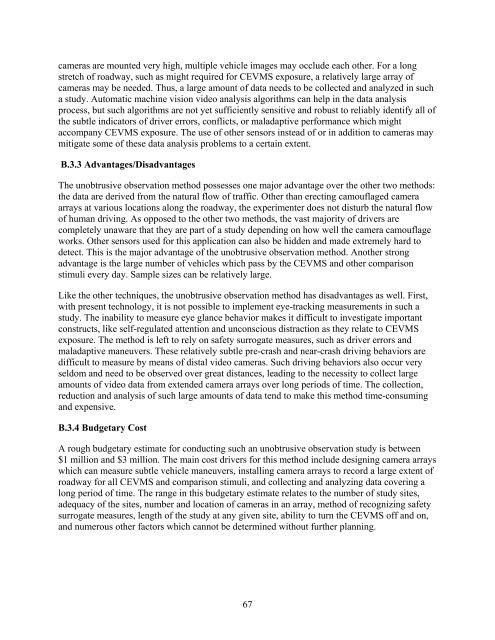The Effects of Commercial Electronic Variable Message Signs ...
The Effects of Commercial Electronic Variable Message Signs ...
The Effects of Commercial Electronic Variable Message Signs ...
You also want an ePaper? Increase the reach of your titles
YUMPU automatically turns print PDFs into web optimized ePapers that Google loves.
cameras are mounted very high, multiple vehicle images may occlude each other. For a long<br />
stretch <strong>of</strong> roadway, such as might required for CEVMS exposure, a relatively large array <strong>of</strong><br />
cameras may be needed. Thus, a large amount <strong>of</strong> data needs to be collected and analyzed in such<br />
a study. Automatic machine vision video analysis algorithms can help in the data analysis<br />
process, but such algorithms are not yet sufficiently sensitive and robust to reliably identify all <strong>of</strong><br />
the subtle indicators <strong>of</strong> driver errors, conflicts, or maladaptive performance which might<br />
accompany CEVMS exposure. <strong>The</strong> use <strong>of</strong> other sensors instead <strong>of</strong> or in addition to cameras may<br />
mitigate some <strong>of</strong> these data analysis problems to a certain extent.<br />
B.3.3 Advantages/Disadvantages<br />
<strong>The</strong> unobtrusive observation method possesses one major advantage over the other two methods:<br />
the data are derived from the natural flow <strong>of</strong> traffic. Other than erecting camouflaged camera<br />
arrays at various locations along the roadway, the experimenter does not disturb the natural flow<br />
<strong>of</strong> human driving. As opposed to the other two methods, the vast majority <strong>of</strong> drivers are<br />
completely unaware that they are part <strong>of</strong> a study depending on how well the camera camouflage<br />
works. Other sensors used for this application can also be hidden and made extremely hard to<br />
detect. This is the major advantage <strong>of</strong> the unobtrusive observation method. Another strong<br />
advantage is the large number <strong>of</strong> vehicles which pass by the CEVMS and other comparison<br />
stimuli every day. Sample sizes can be relatively large.<br />
Like the other techniques, the unobtrusive observation method has disadvantages as well. First,<br />
with present technology, it is not possible to implement eye-tracking measurements in such a<br />
study. <strong>The</strong> inability to measure eye glance behavior makes it difficult to investigate important<br />
constructs, like self-regulated attention and unconscious distraction as they relate to CEVMS<br />
exposure. <strong>The</strong> method is left to rely on safety surrogate measures, such as driver errors and<br />
maladaptive maneuvers. <strong>The</strong>se relatively subtle pre-crash and near-crash driving behaviors are<br />
difficult to measure by means <strong>of</strong> distal video cameras. Such driving behaviors also occur very<br />
seldom and need to be observed over great distances, leading to the necessity to collect large<br />
amounts <strong>of</strong> video data from extended camera arrays over long periods <strong>of</strong> time. <strong>The</strong> collection,<br />
reduction and analysis <strong>of</strong> such large amounts <strong>of</strong> data tend to make this method time-consuming<br />
and expensive.<br />
B.3.4 Budgetary Cost<br />
A rough budgetary estimate for conducting such an unobtrusive observation study is between<br />
$1 million and $3 million. <strong>The</strong> main cost drivers for this method include designing camera arrays<br />
which can measure subtle vehicle maneuvers, installing camera arrays to record a large extent <strong>of</strong><br />
roadway for all CEVMS and comparison stimuli, and collecting and analyzing data covering a<br />
long period <strong>of</strong> time. <strong>The</strong> range in this budgetary estimate relates to the number <strong>of</strong> study sites,<br />
adequacy <strong>of</strong> the sites, number and location <strong>of</strong> cameras in an array, method <strong>of</strong> recognizing safety<br />
surrogate measures, length <strong>of</strong> the study at any given site, ability to turn the CEVMS <strong>of</strong>f and on,<br />
and numerous other factors which cannot be determined without further planning.<br />
67

















